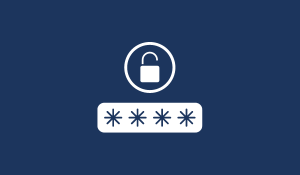Secure passwords 101: 14 tips and tricks for robust protection
Digital life is now inseparable from daily life. We manage our finances, communicate with loved ones, and store sensitive information all online. But...
8 min read
 DriveLock
Jul 28, 2025 9:30:00 AM
DriveLock
Jul 28, 2025 9:30:00 AM

Anyone with an online account - be it for email, social media, banking or accessing corporate networks - is potentially at risk. While we focus on highly sophisticated malware and phishing attacks, many overlook one of the oldest but still highly effective attack methods: the brute force attack. This tactic is not a new invention, but its persistence and adaptability make it a persistent threat to individuals and organizations alike.
| CONTENT |
At its core, a brute force attack is a systematic attempt to guess login credentials. Attackers use automated programs that try countless combinations of usernames and passwords until they find the right one. It's like someone trying to pick a lock by trying every single key on a huge bunch. The sheer computing power of modern computers makes it possible to test billions of combinations in a very short time. The result? A successful brute force attack can result in unauthorized parties gaining access to your personal data, financial information or even critical business systems.
In this blog post, we'll take a closer look at what brute force attacks are and how they work. We will also share practical tips and strategies for preventing such attacks to strengthen your online security and protect your sensitive information.
A brute force attack is a method of systematically trying all possible combinations of passwords, keys or other codes to gain unauthorized access to a system. Automated programs or scripts are used to carry out a large number of attempts in a short period of time. Brute force attacks are time consuming, but potentially effective if the target has a weak password policy or the attacker can devote enough resources to the attack.
The frequency of brute force attacks varies greatly and depends on various factors such as the target, security configuration and access restriction. However, it is known that brute force attacks are a common method regularly used by cybercriminals to gain unauthorized access to systems.
A brute force attack can be illegal because it aims to gain unauthorized access to a system or account, which may violate the laws of the country in question and data protection regulations. Accessing other people's systems without permission and bypassing security mechanisms is a criminal offense in most countries.
It is important that brute force attacks are only carried out in compliance with the applicable laws and with the consent of the system owner, for example as part of penetration tests carried out by authorized experts.
Brute force attacks pose a serious threat to the security of computer systems and personal data. Attackers use this method to gain unauthorized access by systematically trying all possible combinations of passwords, keys or codes.
There are different types of brute force attacks, which differ in their objectives, techniques and the resources used. Understanding these different types is crucial to taking effective security measures and protecting yourself from potential attacks.
Password brute force: This attack involves trying all possible combinations of passwords to gain access to a user account or system. A list of frequently used passwords, dictionaries or algorithmic methods are used to generate the password combinations.
Credential stuffing: This attack uses stolen usernames and passwords from previous data leaks or hacks to log in to various services. Since many users reuse their passwords on multiple websites, attackers may try to try out this stolen information on other platforms.
Token brute force: This involves using tokens or secret keys to gain access to a system. By systematically trying out different combinations, attackers can try to guess or generate valid tokens in order to access protected resources.
Brute force attacks are diverse and, in addition to the examples mentioned, include other variants and specific methods that can be used by attackers. Brute force attacks are considered illegal in most cases.
They violate both applicable security guidelines and data protection regulations. Therefore, it is crucial to implement appropriate security measures to protect against and prevent these attacks.
Brute force attacks are carried out for a variety of motives, usually with the intention of gaining unauthorized access to systems or stealing sensitive information. The motives range from criminal acts such as data theft and identity theft to the identification of vulnerabilities by security experts.
Penetrating other people's systems: Attackers can use brute force attacks to gain unauthorized access to computer systems, networks or online accounts.
Data theft: By cracking passwords or keys, attackers can steal sensitive information such as personal data, bank details or intellectual property.
Identity theft: Brute force attacks allow attackers to impersonate someone else by taking control of user accounts or identities.
Blackmail and extortion attempts: By gaining access to systems or data, attackers can attempt to blackmail victims and demand ransom.
Vulnerability identification: Brute force attacks can also be used by security experts and ethical hackers to uncover vulnerabilities in systems and close security gaps.
If you have discovered that you have been targeted by a brute force attack, it is crucial to act quickly and deliberately. A brute force attack is an attacker's attempt to guess your credentials (such as passwords) by systematically and repeatedly trying all possible combinations. Although this type of attack often involves many failed login attempts and is rarely immediately successful, it can be an indicator of further, more targeted attacks or, if successful, lead to a complete compromise of your account.

Report the incident: Notify the operator of the system or the responsible security officer of the attack immediately. This will allow them to take appropriate action and investigate the incident.
Change your passwords: If the attack targets a specific user account, change the password for that account immediately. Make sure you use a strong and unique password that is not easy to guess.
Check your other accounts: It is advisable to check the passwords of your other accounts as well and change them if necessary. If you use the same access data for different services, it is important to set a unique password for each account.
Monitor suspicious activity: Keep an eye on your accounts and systems and watch for unusual activity or signs of another attack. Monitoring logs and security alerts can help detect such activity.
Update your security measures: Review and improve your security measures to prevent future attacks. This could include implementing additional security mechanisms such as two-factor authentication, IP whitelisting or improved access controls.
Consult experts: If the attack was serious or if you need further assistance, contact IT security experts or cyber security professionals. They can help you investigate the incident, identify vulnerabilities and recommend further protective measures.
Now that we have discussed how you should react in the event of a brute force attack, let's move on to an equally important aspect: prevention. Brute force attacks are one of the oldest and most persistent methods used by cybercriminals to gain access to user accounts. But the good news is that many of these attacks can be prevented with relatively simple but effective measures.
It's not just about reacting to an attack, but taking proactive measures to protect your system and data in the first place. Implementing robust security measures is key to thwarting attackers and significantly minimizing the likelihood of a successful intrusion. The following tips are designed to strengthen your digital security and build a solid defense against this common form of threat.
Use strong passwords: Use complex passwords that consist of a combination of upper and lower case letters, numbers and special characters. Avoid easy-to-guess passwords such as dates of birth or simple words.
Implement account lockouts: Set a limit for failed login attempts and lock user accounts for a certain amount of time after a certain number of failed attempts has been reached. This significantly reduces the effectiveness of brute force attacks.
Strengthen access controls: Implement strong access policies and authentication methods such as two-factor authentication (2FA) or multi-factor authentication (MFA). This increases security as additional information or devices are required for authentication.
IP whitelisting or geoblocking: Restrict access to certain IP addresses or block certain geographic regions to prevent access from suspicious or unusual locations.
Regular updates and patches: Make sure your systems and applications are always up to date. Updates and patches often contain important security enhancements that can close known vulnerabilities that could be exploited by brute force attacks.
Monitoring and logging: Implement comprehensive monitoring and logging of login attempts to detect and quickly respond to suspicious activity.
Limiting the attack surface: Reduce the attack surface by closing services or ports that are not required. The fewer potential entry points there are, the more difficult it will be for attackers to carry out a successful brute force attack.
Create security awareness: Make users aware of secure password practices, such as changing passwords regularly, not sharing or reusing passwords, etc. Training and education can help minimize the risk of brute force attacks.
By implementing these measures, organizations and users can better protect their systems against brute force attacks and significantly reduce the risk of such attacks being successful.
The most important security measure against brute force attacks is a strong password. Read below to find out why it is important to create ones that are not easy to break.
Making decryption more difficult: A strong password with a combination of upper and lower case letters, numbers and special characters makes decryption by brute force methods much more difficult. The more complex the password, the more combinations have to be tried in order to crack it.
Extending the attack time: A strong password extends the time an attacker needs to try out all possible combinations. This increases the likelihood that the attack will be detected or that the attacker will give up in frustration.
Reduction of successful login attempts: Using a strong password greatly reduces successful login attempts in brute force attacks. Attackers are highly unlikely to be able to guess the correct password, preventing access to your account or system.
Password reuse protection: A strong password also protects you from the risk of password reuse. If an attacker gains access to an account, they may try to use the same password for other accounts or services. A strong password reduces the risk that stolen credentials can be used in other areas.
A strong password is crucial to protect personal data and online accounts from unauthorized access. A strong password should contain a combination of different elements that make it difficult to guess or crack through brute force attacks.
It should be sufficiently long, at least 12 characters, and contain a mixture of upper and lower case letters, numbers and special characters. In addition, it is important that a secure password is unique and not reused for different accounts or services.
By being aware of how to create and maintain strong passwords, we can significantly improve our online security and protect ourselves from potential attacks.
Establish guidelines for secure passwords: Implement clear policies and guidelines for password creation in your organization. Set minimum requirements, such as a minimum length, the use of upper and lower case letters, numbers and special characters.
Use password managers: Recommend the use of password managers to generate and store strong and unique passwords. Password managers make it easier to manage and create complex passwords for different accounts.
Training and awareness: Train your employees on password creation best practices and sensitize them to the importance of strong passwords. Give them tips on how to create and manage their passwords.
Implement two-factor authentication (2FA): Encourage the use of two-factor authentication to add an additional security element to passwords. 2FA requires an additional confirmation in addition to the password, such as a one-time code sent via SMS or an authentication app.
Regular password updates: Encourage employees to update their passwords regularly. This helps to ensure security and reduce the risk of compromised passwords.
Implement multi-factor authentication (MFA): For particularly sensitive accounts or data, consider implementing multi-factor authentication. MFA requires multiple independent authentication factors to access an account, such as biometrics or hardware tokens.
Secure password storage: Ensure that passwords are stored in secure databases or encrypted password managers. Avoid storing passwords in plain text or on insecure storage media.
Regular security checks: Conduct regular security audits to check the effectiveness of password security in your organization. Identify weaknesses and take measures to improve password security.
Brute force attacks pose a serious threat to the security of systems and accounts. By systematically trying out different password combinations, attackers attempt to gain unauthorized access. This type of attack can target individual user accounts as well as corporate networks and websites.
To protect against brute force attacks, it is important to use strong and unique passwords, implement access policies, enable account lockouts and continuously monitor systems. In addition, measures such as IP whitelisting, regular updates and patches as well as security training can further reduce the risk of successful brute force attacks.

Digital life is now inseparable from daily life. We manage our finances, communicate with loved ones, and store sensitive information all online. But...

In the digital business world, where the number of online accounts and IT systems used is constantly growing, the protection of sensitive information...

In the dynamic world of IT security, a reactive approach is no longer sufficient. Relying solely on cleaning up after a breach leaves your...